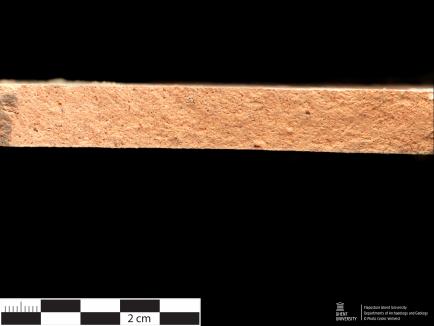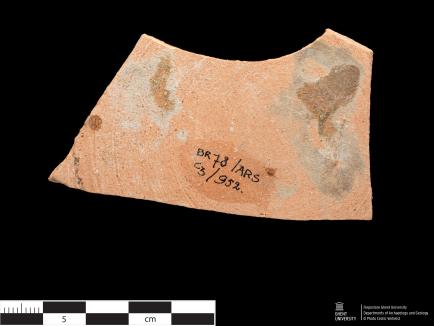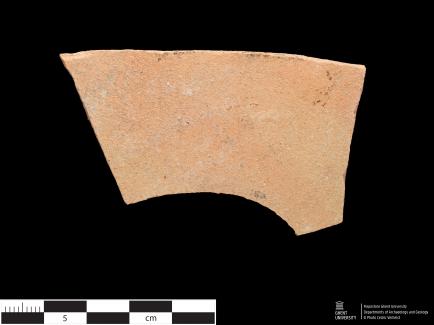Post Medieval - Tin glazed (majolica & faience) (7.TG.BE.0002)
Hand specimen pictures (macro & binocular)
Thin section pictures
Find location
- Category
- Tin glazed (majolica & faience) (Post Medieval)
- Fabric name
- Chronology
- Post Medieval > Modern > 1750-1800
- Dating method(-s)
- morphology, historical sources
- Potters' mark
- No
- Additional information
- biscuit waster (base fragment); referred to as "rough fired ware"
Find location
- Site type
- Pottery production
- Location
- Belgium; West-Vlaanderen; Brugge
- Site name
- Brugge, Arsenaalstraat
- Excavation or Survey Team
- Stedelijke Archeologische Dienst Brugge
- Additional contextual information
- attributed to the workshop/pottery company of Hendrik Pulinx; excavation/site code BR78/ARS; excavation location "Minnewater kasteel"
- Slip
- No
- Slip color
- Glaze
- No
- Glaze type
- Glaze color
- Glaze additives
- Additional information
- Slip
- No
- Slip color
- Glaze
- Yes
- Glaze type
- Glaze color
- Glaze additives
- Additional information
- partial glaze
- Surface color
- pink
- Surface texture
- Smooth
- Fracture color
- pink
- Inclusions (non-plastics/tempering)
- quartz, red inclusions (grog ? quartz ?)
- Matrix and voids
- /
- Diagnostic features
- Additional information
- sample BR_ARS_ST3b
- Flepostore inventory nr.
- ARCH1.L1.A7b
- Original inventory nr.
- B0007
- Collection
- Archaeological Department, Ghent University
- Type
- Covered thin section
- Comparable thin section(s)
- Matrix
-
Majolica (oxidized) light orange fabric; dark brown (PPL), dark brown (XP).
Homogenous matrix, non-calcareous with no optical activity.
- ca. 70-80% - Inclusions
-
Quartz (++; mono+, poly-), sedimentary rock detritus (-; quartz arenite), chert (+-), metamorphic rock detritus (-; low grade), muscovite mica (+-; el), O/Fe (+-; red and black iron oxides), CP/SP (+-; iron-rich).
The coarse fraction consists of medium sand, the fine fraction consists of fine sand, bimodal distribution. Grains are generally rounded to subrounded. Overall the fabric is very poorly sorted and moderately orientated, single to open spaced.
- ca. 15-25% - Voids
-
Large drying cracks along large parts of thin section, few planar/channel and vughs, no infill, well aligned.
- ca. 5% - Diagnostic features
- The fabric is characterized by a homogenous oxidized matrix with no optical activity and low porosity. Dominant quartz inclusions with common chert, muscovite mica, opaques/iron oxides and iron-rich clay pellets, few sedimentary and metamorphic rock detritus. Overall very poorly sorted fabric.
- Additional information
- Similar to B0007a, but better firing conditions and finer fabric.
- Sample type
- Pottery
- Inventory number
- 7.TG.BE.0002
- Collection
- Archaeological Department, Ghent University
- Donating institute/person
- Raakvlak, Onroerenderfgoeddepot De Pakhuizen
- Host collection
- Raakvlak, Onroerenderfgoeddepot De Pakhuizen
- Other samples available
- No
- Sample collection method
- Archaeological Excavation
De Witte 1978
- Full reference
-
De Witte H. 1978. Arsenaalstraat: 18de-eeuwse faïenceindustrie. Het Brugs Ommeland 18, 4: 307.
Van Den Abeele 1986
- Full reference
-
Van Den Abeele A. 1986. De faiencefabriek aan het Minnewater te Brugge (1750-1818). Handelingen van het Genootschap voor geschiedenis 123, 1-2: 61-105.
Cite this page as: Flepostore - https://flepostore.ugent.be/ceramics/7-tg-be-0002
Last modified: 2024-04-24.






